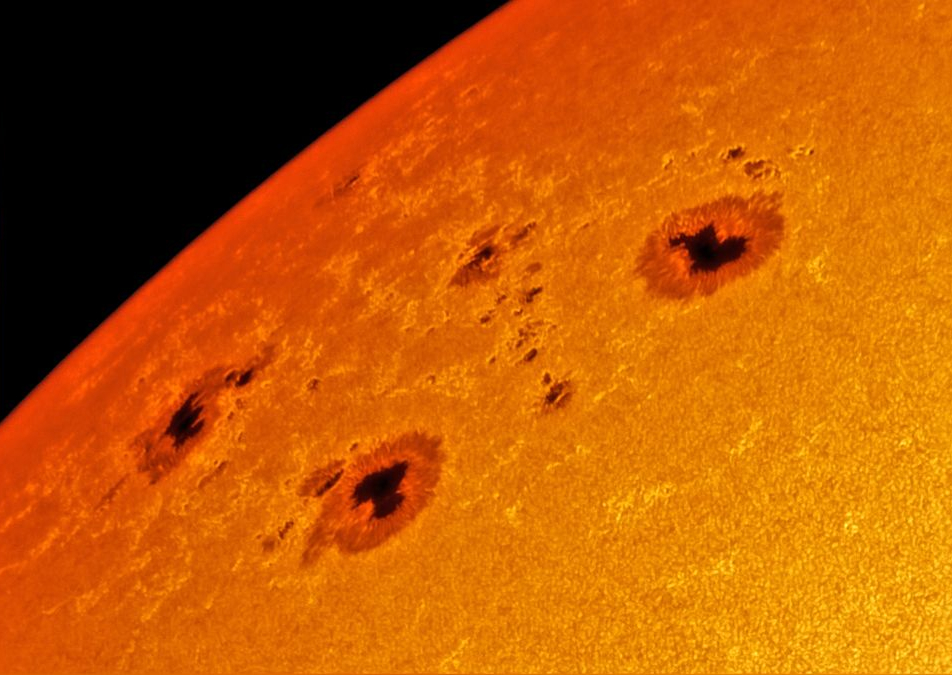Understanding Properties of Nearby Moving Magnetic Features through the Decline of Sunspot Pair

January 30, 2024
Feature
A thorough review of this article has been conducted in line with Science X's editorial process and guidelines. Such an assessment ensures the credibility of the article by focusing on the following attributes:
- Fact-checking
- Peer-review
- Reliance on trusted sources
- Proofreading
By David Appell, Phys.org
Researchers focusing on sunspots have discovered significant indications about the fading magnetic features that could shed light on the development and true roots of these baffling magnetic events. Their findings can be found in The Astrophysical Journal.
Comprehending sunspots is key to understanding the solar cycle, a roughly 11-year recurring shift that alters the sun's energy output and the frequency and power of the flares it emits into space. These flares can potentially disrupt satellites and electrical grids on Earth. The solar 'cycle' can last anywhere from eight to 14 years.
From a distance, sunspots might seem simple, but they are intricate areas where sunlight is trapped by twisted magnetic fields. These transient regions of lower temperature show up as dark spots on the sun’s surface, where the restricted magnetic flow hinders convection that carries the sun's internal heat to the surface. Sunspots are approximately the size of Earth and often come in pairs.
The decay of sunspots is also a complex process. Sunspots' central umbra is dark with potent magnetic fields, while the surrounding penumbra, which may encompass multiple sunspots, is brighter (but still darker than the sun) and is made up of elongated parts known as penumbral filaments.
Complete sunspots are encircled by granular convection regions that can form larger structures called moat cells, mostly nonmagnetic annular areas. These moat cells expand 10 to 20 million meters beyond the sunspot penumbra's border.
Inside the moat cell is the moat flow, a slow outflow of plasma that moves radially away from the sun's center, i.e., away from the sunspot. Within these movements, small moving magnetic features (MMFs) that depend on the penumbra's magnetic fields drift away from the sunspot.
In 2022, Chinese scientists observed two adjoining sunspots for a span of seven days to study the connection between the sunspots’ magnetic flux decay and the transportation of magnetic flux by the MMFs. ('Magnetic flux' is the flow of magnetic field lines through a defined area.)
The sunspots circled anticlockwise around each other at an approximate rate of 13 degrees per day for the first five days, and then the rotation halted. By tracking changes in solar intensity relative to the solar quiet region, they established the boundaries of the umbra and penumbras to observe the plasma's horizontal velocity fields, which provided estimates for the MMFs’ magnetic flux.
The pair of sunspots deteriorated at a rate of nearly 15 million km2 per day, an area similar to the size of Antarctica. Accordingly, the decrease in magnetic flux through the sunspot was around 1020 maxwells per day, where a maxwell is the unit of magnetic flux, equivalent to one gauss per cm2. (On Earth, the magnetic field is typically between 0.2 to 0.6 gauss.)
Within this process, MMFs, the small magnetic volumes that flow radially away from their sunspot, had a size about 2 arcseconds as seen from Earth, and moved approximately 400 meters per second.
The link between the loss of magnetic flux from a decaying sunspot and MMFs remains enigmatic. However, the parameters measured in this research confirm that "the formation of moving magnetic features is dependent on penumbral magnetic fields," according to Yang Peng and Zhike Xue. They are the authors of the study, affiliated respectively with the Yunnan Observatory of the Chinese Academy of Sciences and the University of Chinese Academy of Sciences.
They further added, "Our results show that in the penumbra-free region, a large number of MMFs are produced, and the vertical MMFs (MMFs with a vertical magnetic field) in this region have significantly increased compared to those around the penumbra. This is closely related to the naked umbra in the granule."
These observations propose that MMFs with vertical magnetic fields are closely linked to sunspot disintegration. Most of the MMFs from the gap between the two sunspots might directly originate from the sunspot umbra. "The results provide possible clues for the real origin of MMFs," Peng and Xue concluded.
Journal information: Astrophysical Journal
© 2024 Science X Network




